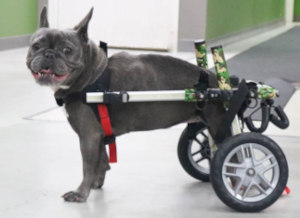- January 23, 2024
How to Use a Dog Wheelchair for Rehabilitation & Recovery


Helping an injured dog get back on its feet is a vital part of the recovery process. A dog wheelchair can play an integral role in a dog’s rehabilitation. A cart allows the dog to stand upright instead of lying down, and it can also improve recovery times. Adding a five to ten-minute cart walk into a dog’s treatment plan several times a day will help the dog physically and lift its spirits.
Many dogs in wheelchairs use them due to old age, weakness, or paralysis and are destined to use them for the rest of their lives. Others may only need to use the wheelchair for a couple of months or weeks even. Many vets and rehabilitation centers will encourage the use of a wheelchair for pets in recovery from surgery or injury.
Many dogs suffering from ACL or knee injuries will use a dog wheelchair as they heal. A wheelchair makes the process easier both for the dog and their family. In this article, I will discuss the common illnesses and injuries they can assist with, as well as why a wheelchair is beneficial for dog rehabilitation.
Using a Dog Wheelchair for Hind Leg Rehabilitation

While there are many different reasons a dog could need a wheelchair the most common causes are due to injury, paralysis, recovery from surgery, or disease. While not all of these can be reversed a set of dog wheels can assist them all and, in some scenarios, even assist in rehabilitation from an injury, surgery, or in some cases paralysis from a neurological condition or birth defect.
A dog wheelchair is an important rehab tool for dogs with back leg injuries or recovery. Here are some of the most common cases a dog could use a wheelchair to help with rehabilitation.
Dog Wheelchair and Therapy: How does it work?

A dog wheelchair is considered a mobility aid. The primary function of a wheelchair is to make it easier for a dog to walk. A dog may need a wheelchair due to an injury, weak hind legs, or a medical condition impacting its ability to walk (such as DM or IVDD). Wheelchair use isn’t limited to only paralyzed pets. A wheelchair can be incredibly beneficial for dogs with knee injuries, during post-surgical recovery, and those with painful joint conditions.
The two most common wheelchair styles used in therapy include:
- Rear Wheelchair for supporting a pet’s back legs
- Full Support Wheelchair provides support to all four limbs
The cart encourages walking by reducing the weight the pet places on its weak legs. In addition, the rear wheelchair’s support system supports underneath the pet’s pelvis with the cart’s wheels in line with the dog’s hips allowing them to use their hind legs without straining themselves. When used properly a wheelchair helps dog rebuild muscles in their legs and regain their strength through continued exercise.
Dogs using a quad cart will receive the same support in the hind end while also aiding the front legs. The front leg support is directly under the dog’s chest, with the front wheels in line with the shoulders. By assisting the front and back legs simultaneously, the dog receives balanced support that should make it easier for them to stand and walk. In addition, a 4-wheel cart will allow for more movement and encourage weight bearing earlier in a pet’s recovery. Full-support wheelchairs are especially beneficial for dogs recovering from injury or surgery.
The Benefits of Wheelchair Use During Rehabilitation

For dogs in physical therapy, the wheelchair assists them during their training, helping them to stand and supporting them as they move. The goal for many pets in rehab is to strengthen their legs and build up the dog’s stamina. A canine cart can help pets achieve both of these goals.
When a dog first starts in their cart, expect them to tire quickly, remember they haven’t walked in a while. Although it will take time for the dog to rebuild its strength, we recommend starting with short walks that slowly increase in time. For example, most dogs begin with six to ten minutes of cart time on their first wheelchair walk. Then, as a general rule of thumb, allow at least two hours between walks. This gives your pet the time they need to rest and recover.
Physical benefits of using a dog wheelchair during rehabilitation include:
- Increased stamina
- Rebuild muscle strength
- Improved balance and support
- Minimize muscle loss
- Regain independence
- Encourage exercise
- Get the dog upright and mobile sooner
- Allows for weight bearing on injured or weak legs
- Makes it easier to get the dog outside to go to the bathroom
Neurological Conditions and Recovering from a Stroke

While the process of recovery is different based on many outside factors, the Walkin’ Rear and Quad Wheelchairs have been able to assist in recovery from strokes and other neurological conditions. We have seen wheelchair based rehabilitation work for the below issues and conditions:
- Paralysis of one side of the body
- Immobility or paralysis in a single limb
- Paralysis in front both front limbs or rear limbs
- Weakened back legs
- Loss of Coordination
- Slipped Disc
- Stroke
While some dogs who suffer from paralysis on one side of the body tend to go in circles at first over time as they develop strength in their legs again as they won’t have to worry about bearing weight can then assist them in eventually using their weakened legs on their own over time. Please be advised for specific instructions and a detailed rehab plan needs to come from your Vet or Rehab specialist so they can find what will work best for you and your pet and if rehab is a viable option for them.
Recovering from Injury or Surgery

Assistance in recovering from a physical injury or post-surgical are both very common reasons for the use of a dog or pet Wheelchair. Making sure your dog has the extra weight and pressure taken off of their injury or spot of their recent surgery is a huge part of the healing process. Making sure your dog is healing properly and safely, but still able to have some independence when walking around and going potty is an important part of recovery both physically and mentally for them.
Healing after an injury or surgery are some of the most common reasons why a dog would require a dog wheelchair. Some of the common injuries and surgeries that benefit from wheelchair rehabilitation include:
- ACL (Knee) Tear
- Post ACL repair or knee surgery
- Trauma to rear end
- Broken Legs
- IVDD (Spinal) related surgeries
- Hip Dysplasia
- THP – Total Hip Replacement Surgery
- Amputation of one or more Limbs
If a dog has just had an ACL repair surgery on their knee or even a Total Hip Replacement getting these dogs the movement they need while in recovery can be tough. As a dog heals it’s crucial that extra weight and pressure is not being placed on the injured leg. This is especially difficult in injured large dogs. Many large dogs benefit from using a wheelchair while they recover. Using a dog wheelchair allows dogs to remain mobile and can give families peace of mind that their dog can still be active while staying safe. Additionally, using a wheelchair eliminates the risk of pet parents injuring themselves or straining their back lifting a heavy dog.
At Home Physical Therapy with a Dog Wheelchair
Your dog’s treatment plan will be unique and designed to benefit your dog’s individual mobility needs based on their health needs. You should always work closely with your rehab specialist to develop the right rehabilitation plan for your dog. There are many at-home treatments, therapies, and exercises to benefit your dog’s recovery. Always discuss any treatments with your dog’s medical professional before trying them at home. Some different kinds of physical therapy you can do with your dog while in their wheelchair are as follows:
- Strength Training
- Passive Range of Motion (PROM)
- Stand and Count
- Stand and Shift Weight
Conclusion
While some dogs will need to use a wheelchair for the rest of their lives, many have been able to use it to assist in rehabbing their condition. Dogs in wheelchairs can be just as happy as dogs who are not using one and it may even be a way to rehabilitate your dog. Temporary use of a wheelchair gives your pet their mobility again and is a key reason why dog wheelchairs are so important.
Whether recovering from surgery or a neurological condition, using a dog wheelchair as part of your dog’s rehabilitation plan with your Vet or Rehab Specialist is a great way to help your dog through the process safely and with support. As the Walkin’ Wheels is easy to use it makes guided rehab for difficult conditions much easier in your own home.

Related Articles:
Tags
What do you think?
Related Articles

New Puppy Checklist: Gear You’ll Need for Your New Dog
Getting a new puppy is really exciting, but before you welcome them home, it’s important to prepare your space for them. Since puppies need a

How Big Do Mini Poodles Get? Vet Reviewed Average Weight & Growth Chart – Dogster
The information is current and up-to-date in accordance with the latest veterinarian research. Learn more » When you buy a Miniature Poodle, you might not

Can Police Dogs Smell Nicotine? Vet Verified Facts & Info – Dogster
The information is current and up-to-date in accordance with the latest veterinarian research. Learn more » While cigarette sales have been declining steadily for decades,

How Old Is 5 in Dog Years? Vet-Approved Guide to Each Size of Dog – Dogster
The information is current and up-to-date in accordance with the latest veterinarian research. Learn more » A common method for calculating a dog’s age is



